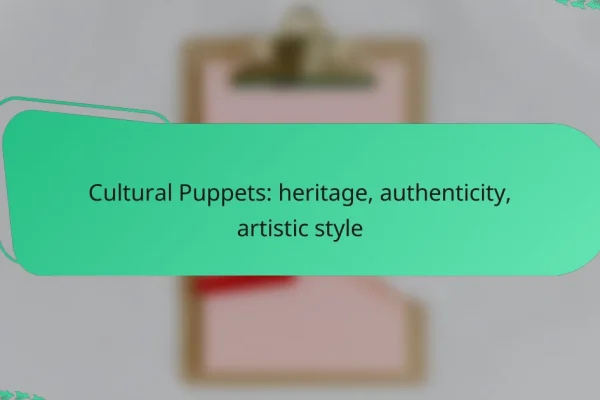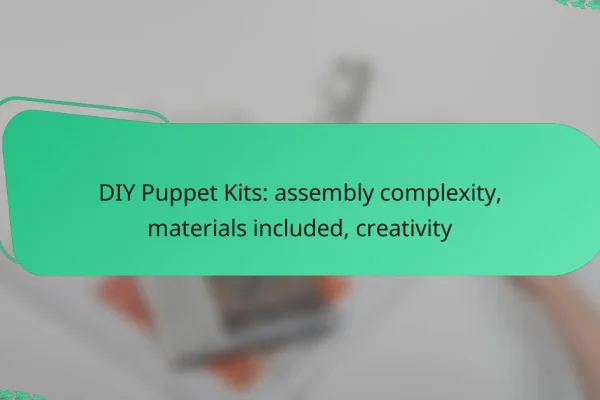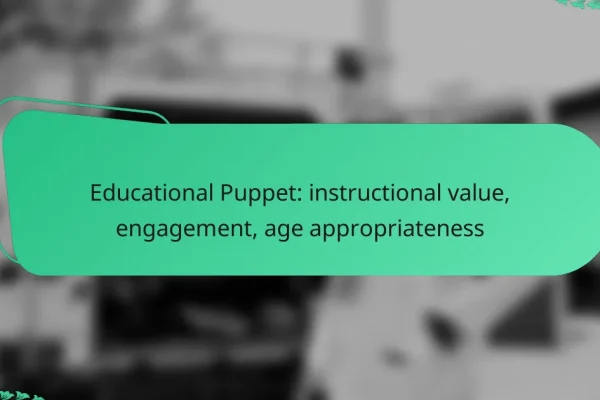What are the best puppets for beginners in Australia?
The best puppets for beginners in Australia include hand puppets, finger puppets, and marionettes. These options are user-friendly, versatile, and suitable for various types of play and performance.
Hand puppets for storytelling
Hand puppets are ideal for storytelling as they allow for expressive movements and easy manipulation. They typically cover the entire hand and forearm, making it simple to create engaging characters and narratives.
When selecting hand puppets, consider their material and size. Soft, lightweight fabrics are easier to handle, while larger puppets can be more visually impactful. Popular choices include animal characters and classic fairy tale figures.
Finger puppets for interactive play
Finger puppets are perfect for interactive play, especially with young children. These small puppets fit on individual fingers, allowing for quick changes and multiple characters in a single performance.
Look for sets that include a variety of characters to enhance creativity. Finger puppets are often made from felt or soft plastic, making them durable and safe for kids. They are also affordable, usually ranging from AUD 5 to AUD 20 for a set.
Marionettes for performance art
Marionettes are more complex puppets that are controlled by strings, making them suitable for performance art. They require more skill to operate but can create stunning visual effects when performed well.
Beginners should start with simpler marionettes that have fewer strings and straightforward movements. Prices can vary widely, from around AUD 20 for basic models to several hundred for intricate designs. Consider taking a workshop to learn the basics of marionette manipulation.
How to choose a puppet based on age group?
Choosing a puppet based on age group is essential for ensuring that it is safe, engaging, and developmentally appropriate. Consider the child’s interests, motor skills, and cognitive abilities when selecting a puppet.
Puppets for toddlers
Puppets for toddlers should be simple, colorful, and easy to manipulate. Look for soft, plush puppets that are safe for young children, avoiding small parts that could pose a choking hazard. Finger puppets and hand puppets with large openings are ideal, as they encourage imaginative play and help develop fine motor skills.
Puppets for preschoolers
Preschoolers benefit from puppets that are slightly more complex, often featuring interactive elements like sounds or textures. Puppets that tell stories or represent familiar characters can enhance language development and social skills. Consider puppets that can be easily washed, as preschoolers may engage in messy play.
Puppets for school-aged children
School-aged children can handle more intricate puppets, including marionettes or puppets with movable parts. These puppets can foster creativity and storytelling, allowing children to create their own narratives. Encourage children to use puppets in group settings to promote teamwork and communication skills.
What materials are best for puppets?
The best materials for puppets depend on their intended use, durability, and maintenance needs. Common options include fabric, wood, and plastic, each offering unique benefits and considerations.
Fabric puppets for durability
Fabric puppets are known for their durability and versatility. They can withstand frequent handling and are often used in educational settings or performances where longevity is essential. Look for materials like cotton or fleece, which are soft yet resilient.
When choosing fabric puppets, consider the stitching quality and the type of fabric used. Puppets made from thicker materials tend to last longer, while lighter fabrics may be more suitable for casual use. Regular cleaning can help maintain their appearance and functionality.
Wooden puppets for traditional use
Wooden puppets are often favored for their classic aesthetic and craftsmanship. They are typically used in traditional puppet theaters and can convey a sense of nostalgia. The weight and balance of wooden puppets can enhance performance, making them ideal for skilled puppeteers.
However, wooden puppets may require more care to prevent damage. Ensure they are treated with non-toxic finishes and stored properly to avoid warping. They are less suitable for environments where rough handling is expected.
Plastic puppets for easy cleaning
Plastic puppets are popular for their ease of cleaning and maintenance. They are often used in settings like schools or daycare centers, where hygiene is a priority. A simple wipe with a damp cloth can keep them looking fresh.
While plastic puppets may not have the same aesthetic appeal as fabric or wood, they are lightweight and durable. Consider their construction quality, as thicker plastic tends to be more resilient against wear and tear. Avoid exposing them to extreme temperatures to prolong their lifespan.
How do I select a puppet for educational purposes?
Selecting a puppet for educational purposes involves considering the age group, learning objectives, and the specific skills you want to develop. Look for puppets that are engaging, durable, and easy to manipulate, as these factors can significantly enhance the learning experience.
Storytelling puppets for literacy
<p Storytelling puppets can effectively promote literacy by making narratives more engaging. Choose puppets that represent various characters, as they can help children visualize stories and improve comprehension. For example, a puppet resembling a popular storybook character can captivate young readers and encourage them to explore books.
<p When selecting storytelling puppets, consider their size and ease of use. Puppets that are too large may be cumbersome for small hands, while those that are easy to manipulate can enhance interaction during storytelling sessions.
Role-play puppets for social skills
<p Role-play puppets are excellent tools for teaching social skills, as they allow children to practice interactions in a safe environment. These puppets can represent various social scenarios, helping kids learn about empathy, communication, and conflict resolution. For instance, using puppets to enact a situation where sharing is necessary can illustrate the importance of cooperation.
<p When using role-play puppets, encourage children to express their thoughts and feelings through the puppets. This approach not only makes learning fun but also helps them develop confidence in their social interactions.
Custom puppets for specific lessons
<p Custom puppets can be tailored to address specific educational themes or lessons, making them highly effective for targeted learning. For example, a puppet designed to represent a historical figure can bring history lessons to life, fostering greater interest and retention among students.
<p When considering custom puppets, think about the lesson objectives and the characteristics that would best support those goals. Collaborating with a puppet maker can ensure that the puppet aligns with your educational needs while remaining engaging for students.
What are the price ranges for quality puppets in Australia?
In Australia, quality puppets can range from budget-friendly options under $20 to premium selections exceeding $50. Understanding these price ranges helps you choose a puppet that fits your needs and budget.
Budget puppets under $20
Budget puppets priced under $20 are ideal for casual use or beginners. These puppets often feature simpler designs and materials, making them accessible for children or those just starting with puppetry.
While they may lack some durability and intricate details, you can find a variety of characters and styles. Look for options in toy stores or online marketplaces for the best selection.
Mid-range puppets between $20 and $50
Mid-range puppets, priced between $20 and $50, offer a balance of quality and affordability. These puppets typically feature better craftsmanship, more detailed designs, and durable materials, making them suitable for regular use.
In this price range, you can find a wider variety of puppets, including hand puppets, finger puppets, and marionettes. Consider checking specialty toy stores or online retailers for unique options that stand out.
Premium puppets over $50
Premium puppets priced over $50 are crafted with high-quality materials and exceptional attention to detail. These puppets are often designed for professional use or serious hobbyists who require durability and realism.
In this category, you can expect features like intricate costumes, realistic facial expressions, and superior articulation. Look for brands known for their craftsmanship, and consider investing in these puppets for performances or educational purposes.
What brands are known for high-quality puppets?
Several brands are recognized for producing high-quality puppets, with Folkmanis and Melissa & Doug standing out for their unique offerings. These brands focus on creativity and educational value, making them popular choices among parents and educators alike.
Folkmanis for creativity
Folkmanis is renowned for its imaginative puppet designs that encourage creative play. Their puppets often feature intricate details and vibrant colors, appealing to children’s sense of wonder and storytelling.
When selecting a Folkmanis puppet, consider the themes that resonate with your child, such as animals, fantasy creatures, or even characters from popular stories. This brand offers a wide range of options, typically priced between $20 and $100, depending on the complexity and size of the puppet.
Melissa & Doug for educational value
Melissa & Doug puppets are designed with educational purposes in mind, promoting interactive learning through play. Their puppets often come with features that encourage role-playing and storytelling, making them excellent tools for developing social skills and creativity.
Look for puppets that align with educational themes, such as community helpers or animals, which can enhance learning experiences. Prices for Melissa & Doug puppets generally range from $10 to $50, making them accessible for various budgets.















